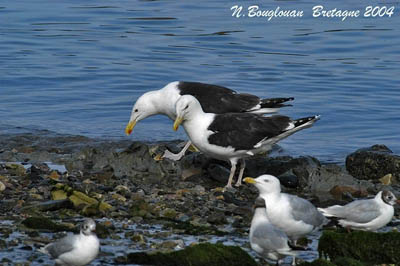
Great Black-backed Gull
Larus marinus
Charadriiforme Order – Laridae Family
BIOMETRICS:
Length: 68-79 cm
Wingspan: 150-167 cm
Weight: 1400-2300 g
LONGEVITY: up to 23 years
DESCRIPTION:
Great Black-backed Gull is the largest gull in the world, and it is rather a coastal species.
Adult in breeding plumage has black back and wings. It has large white spots at tip of outer black primaries.
The massive bill is yellow with red spot on lower mandible. Eyes are yellow with red eye-ring. Legs and feet are flesh-coloured.
Adult in winter plumage has almost similar plumage, except on head and neck which are slightly streaked with greyish-brown. Primaries show white tips but less conspicuous. The strong yellow bill is duller as the red patch.

Great Black-backed Gull has large wings, with broad white trailing edges and thin white leading edges. It also has massive head, bill and neck.
Both sexes are similar, but male is more massive than female which appears slightly smaller.
Juvenile has heavily mottled white and brown plumage. Bill is blackish.
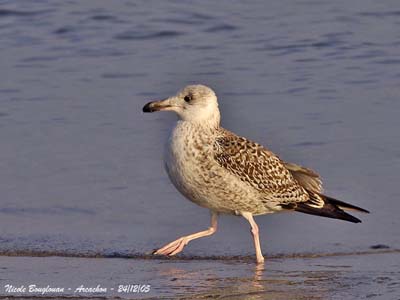
Immature is similar, but head and breast are whiter. Tail has black subterminal band. Bill is pale with black tip.
The naked parts reach the adult colours little by little. Back and wings become dark grey to black in the 4th year. At this moment, the bird still presents some brownish tinge on wing coverts.
Young may breed at 4-5 years of age.
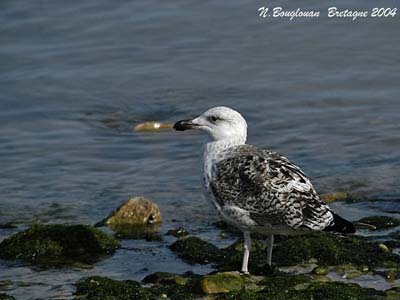
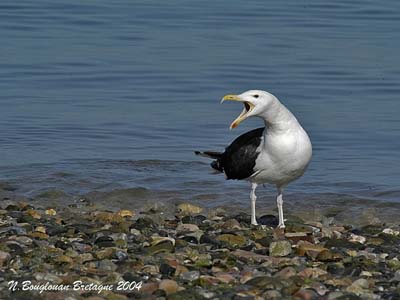
VOICE:
Great Black-backed Gull utters deeper and gruffer calls than other large gulls. The deep “oow-oow-oow” is characteristic.
HABITAT:
Great Black-backed Gull frequents open sea, estuaries, rocky and sandy coasts. It may be found inland in large waters or in fields.
This species breeds on islands and dunes, and prefers vegetated nesting-sites.
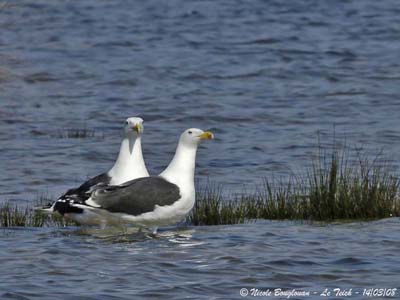
RANGE:
Great Black-backed Gull breeds on European and North American coasts, and also on islands in North Atlantic.
This species is often sedentary, but the birds of the northern parts of the range such as High Arctic gulls, migrate southwards. The other populations only travel short distances in winter.
The birds of Iceland move around the island. Populations of northern parts migrate as west or east, according to the range.
In North America, they may reach the Gulf Coast.
BEHAVIOUR:
Great Black-backed Gull is omnivorous and opportunistic. It is a predator of eggs and chicks of other species such as smaller gulls, seabirds and ducks. It is very aggressive and able to kill adult birds.
It also takes terrestrial mammals such as rodents, rabbits, rats and mice. It captures the prey on the shore or near the surface of water.
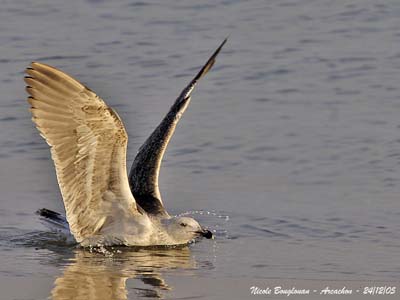
It uses the typical method for molluscs and large eggs, dropping them on hard surface in order to crack open the shells.
It also takes carrion on shores or at rubbish dump. Piracy also occurs and it steals food from other smaller gulls. It is able to swallow large preys whole.
Great Black-backed Gull nests solitary or in small colonies. It defends strongly territory, eggs and chicks against other gulls’ species. The territory size depends on the size of the species, the number of pairs in the colony, and the nesting area.
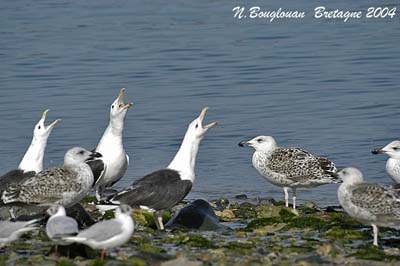
Large gulls as this one usually nest in relatively large territories and in open colonies. If the territory is not large enough, cannibalism may occur between neighbours. This large bird increases its territory after hatching, in order to avoid this problem which is an important cause of chick’s mortality and low reproductive success.
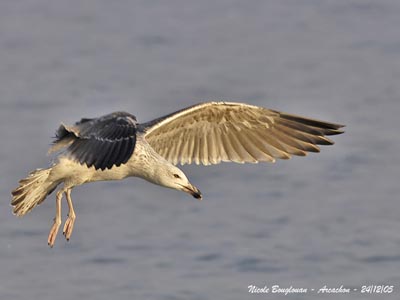
FLIGHT:
Great Black-backed Gull performs slow flight with powerful wing beats. It also may glide low over the sea.
REPRODUCTION:
Breeding season occurs from early April in southern parts of the range, to mid-May in northernmost areas.
Great Black-backed Gull nests on ridges, outcrops and pinnacles, and locally on roofs.
The nest is bulky, scraped into the ground in sandy, grassy or rocky soil. It is close to rock or vegetation’s shelter. It is made with dry grasses, moss and algae. Interior is lined with several kinds of materials such as feathers, plastic, rope, vegetation and other varied items.
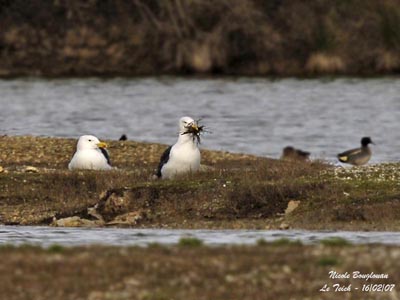
Female lays 1-3 olive-greenish or brownish eggs. Incubation lasts about 27 days, shared by both parents. Chicks are covered with pale grey down with conspicuous black spots. They are fed by both adults. They leave the nest 2-3 weeks after hatching, and they are able to fly 7-8 weeks later.
DIET:
Great Black-backed Gull feeds on wide variety of food such as fish, adult and young birds and eggs, marine invertebrates, insects, rubbish, carrion and berries.
This aggressive predator may kill adult birds. It also feeds on mammals such as rodents, rabbits, rats and mice, and even young lambs in Iceland.
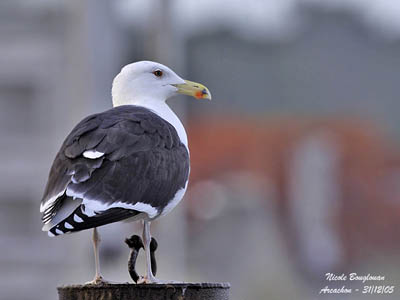
PROTECTION/ THREATS/ STATUS
Great Black-backed Gull’s populations are not globally threatened and widespread throughout the range.
Fr: Goéland marin
All : Mantelmöwe
Esp: Gavión Atlántico
Ital: Mugnaiaccio
Nd: Grote Mantelmeeuw
Russe: Морская чайка
Sd: Havstrut
Photographs and text by Nicole Bouglouan
Sources :
HANDBOOK OF THE BIRDS OF THE WORLD Volume 3 by Josep del Hoyo-Andrew Elliott-Jordi Sargatal - Lynx Edicions - ISBN : 8487334202
THE HANDBOOK OF BIRD IDENTIFICATION FOR EUROPE AND THE WESTERN PALEARCTIC by Mark Beaman, Steve Madge - C.Helm - ISBN: 0713639601
All About Birds (Cornell Lab of Ornithology)
Wikipedia (Wikipedia, The Free Encyclopedia)